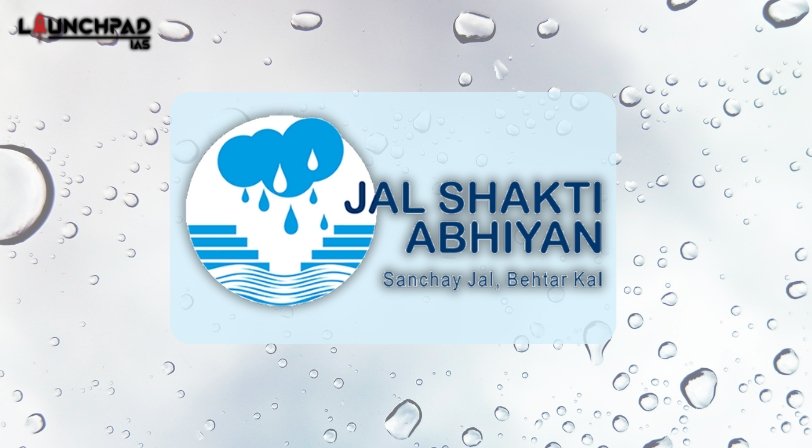About
The Jal Shakti Abhiyan mainly focuses upon the conservation of water in 1592 water-stressed blocks in 256 districts. It also ensures five important water conservation interventions:
- Rainwater harvesting
- Renovation of traditional and other water bodies/tanks
- Reuse bore well recharge structures
- Watershed development
- Intensive afforestation.
This campaign converged funds of all water conservation-related schemes (MGNREGS, AMRUT, CAMPA Funds, etc) of central and state governments, funds raised locally and from corporate sectors also.
Salient Features Of Jal Shakthi Abhiyaan
- Using a comprehensive strategy to accelerate the programmatic implementation of water conservation activities
- Is a mission-mode campaign with a time limit to improve groundwater conditions in the 256 districts’ water-stressed blocks
- Intervention with five goals: water conservation and rainfall harvesting; rehabilitation of conventional and non-conventional waterbodies/tanks; reuse and recharging of bore wells; and intense afforestation.
- Providing a significant boost in infrastructure responsiveness to water conservation
- Incorporating citizen participation along with community involvement throughout the monsoon season
- Carrying on as a Jan-Andolan along the lines of the Swachh Bharat Mission; assisting people in working for the collection of rainwater and maintenance of ponds and village tanks.
- This campaign drives to make check dams, water harvesting pits, rooftop RWHS, etc
- Removal of encroachments and de-silting of tanks to increase their storage capacity
- Remove obstructions in the channels which bring water to them from the catchment areas etc
- Repairs to step-wells and using defunct bore wells and unused wells to put water back to aquifers etc are to be taken up with the active participation of people.
- To facilitate these activities, states have been requested to open “Rain Centers” in each district
Traditional Water Conservation Methods in India
North East India
- Bamboo Pipes: In this simple method, water is transported through bamboo pipes for irrigation. Bamboo pipes are used to divert water from springs on the hilltops to the lower regions by gravity

- Apatani: It is a wet rice cultivation cum fish farming system practiced in elevated hilly regions and gently sloping valleys of Northeast India. Apatani can tap the water of small streams and springs in these high rainfall-hilly regions through their temporary walls. These walls act as barriers and can divert the flow of water towards terraced and valley lands.

Indo Gangetic Plains
- Ahar–Pyne: It is a traditional floodwater harvesting system prevalent in Bihar. Ideal terrain for Ahar-pyne should have an evident slope, sandy soil, low groundwater level and flood during monsoon.

Rajasthan, Gujarat and the Western Deserts
- Kunds or Kundis: In western arid areas of Rajasthan, kunds are water-harvesting structures. They have a saucer-shaped catchment area that gently slopes towards the centre where the well is situated. A wire mesh across water-inlets prevents debris from falling into the well pit. The sides of the well-pit are generally covered with lime and ash.

- Nadis: It is the local name of a village pond used for storing rainwater from the adjoining natural catchment areas. These were very common in Jodhpur.

South India
- Eri and Kulams: Tamil Nadu has no perennial river that can cover the whole state. This inspired people to use monsoon rains for irrigation and filling the ponds for consumption and other purposes. It has been mentioned that approximately one-third of the irrigated area of Tamil Nadu is watered by the Eris (tanks). Eri is the name given to a broad irrigation tank while Kulam is a small pond located close to a temple. Eris are used for cultivation, and Kulam for drinking water purpose.

Deccan and Maharashtra
- Kohli Tank: They are called so because of the name of a group of cultivators who built these tanks three centuries back. A network of channels to practically carry water to every house was in existence in the Bhandara district of Maharashtra. The tanks were built on the slopes of the Gaikhuri range
How can the Revival/Protection of Water Bodies be Ensured?
- Focus should be on sustainability. Therefore, emphasis should be on long-term goals, operation and maintenance, adequate budget, and ownership and responsibility to the people.
- The economic, environmental, and social impact of the project should be studied in detail beforehand and reviewed in between for the course correction. Local communities need to be involved in all these planning and reviews.
- Encouraging local people to collaborate with other stakeholders to successfully utilize resources should be done to ensure the protection and conservation of water bodies.


